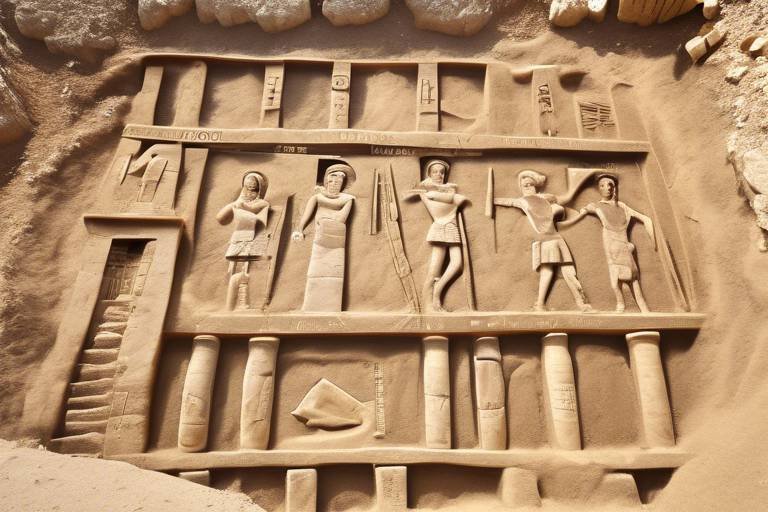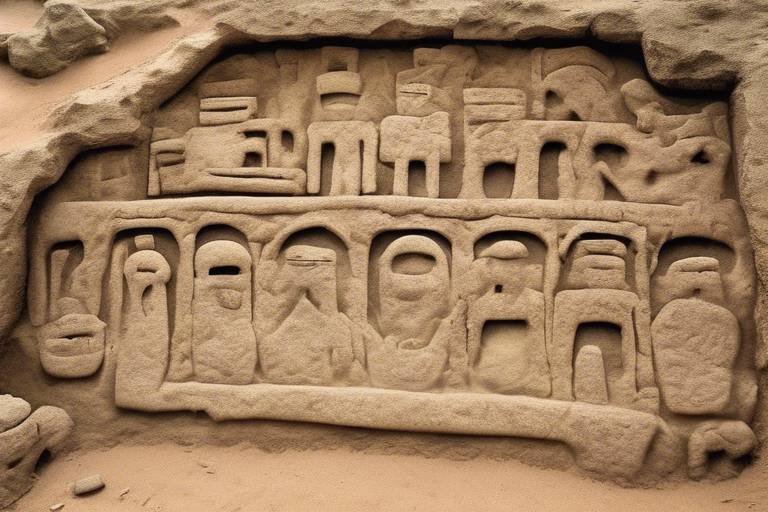Gobekli Tepe - The World’s Oldest Temple?
Gobekli Tepe, located in southeastern Turkey, has long been a subject of fascination for archaeologists and historians alike. This ancient site, dating back over 11,000 years, challenges conventional beliefs about the capabilities of early human societies and their religious practices. The intricate stone structures and carvings found at Gobekli Tepe hint at a level of sophistication previously unseen in prehistoric cultures. Could this be the world's oldest temple, a place where ancient rituals and beliefs were once practiced?

Discovery and Significance
Exploring the mysteries surrounding Gobekli Tepe takes us on a journey through time, unraveling the enigmatic origins of this ancient archaeological site nestled in Turkey. The discovery of Gobekli Tepe holds immense significance in reshaping our understanding of early human civilizations and the evolution of religious practices.
Uncovered by archaeologist Klaus Schmidt in the 1990s, Gobekli Tepe stands as a testament to the advanced knowledge and skills possessed by its ancient builders. The site's intricate stone structures and elaborate carvings challenge conventional beliefs about the capabilities of early societies, sparking a wave of excitement and curiosity among researchers and historians alike.
The architectural marvel of Gobekli Tepe is not limited to its physical structures but extends to the artistic depictions found within its reliefs. Symbolic motifs and intricate animal figures adorn the stones, offering a glimpse into the beliefs and cultural practices of the people who once inhabited this sacred place.
Placing Gobekli Tepe within the context of human history raises thought-provoking questions about the timeline of civilization. The ongoing debate surrounding the site's carbon dating adds a layer of complexity to its narrative, fueling discussions about the chronological implications of this ancient marvel.
Delving into the religious interpretations of Gobekli Tepe unveils a tapestry of theories regarding its spiritual significance. Some scholars suggest that the site served as a center for shamanic rituals, where ancient ceremonies and practices were conducted to connect with the divine and seek guidance from the spiritual realm.
As we reflect on the legacy of Gobekli Tepe and the ongoing research efforts dedicated to unraveling its mysteries, we are reminded of the profound impact this ancient site has had on shaping our understanding of prehistoric cultures. The quest to decipher the secrets of Gobekli Tepe continues to captivate the imagination of scholars and enthusiasts worldwide, promising new revelations and insights into the dawn of human civilization.

Architectural Marvel
Exploring the mysteries surrounding Gobekli Tepe, an ancient archaeological site in Turkey that challenges our understanding of human civilization's origins and religious practices.
Uncovering the history behind the excavation of Gobekli Tepe and its importance in reshaping archaeological narratives about early human societies.
Gobekli Tepe stands as a testament to the architectural prowess of its ancient builders. The site features intricately carved stone pillars adorned with elaborate motifs and symbols, showcasing a level of craftsmanship that defies the conventional wisdom about the capabilities of early human civilizations.
Within the stone structures of Gobekli Tepe, one can find a rich tapestry of artistic depictions, including intricate reliefs of animals and symbolic motifs. These carvings not only demonstrate the artistic sophistication of the builders but also offer valuable insights into the cultural and religious beliefs of the ancient society that created them.
Placing Gobekli Tepe within the timeline of human history is a challenging task due to its enigmatic nature. The site's existence predates conventional notions of civilization, prompting scholars to reconsider the trajectory of human development and the factors that may have influenced the rise of complex societies.
The dating of Gobekli Tepe has sparked heated debates among archaeologists and historians. Some argue that its age pushes back the timeline of human civilization, while others question the reliability of the dating methods used. This controversy underscores the significance of Gobekli Tepe in reshaping our understanding of the past.
Gobekli Tepe has been the subject of various religious interpretations, with scholars speculating about its role in ancient spiritual practices. Some propose that the site served as a center for shamanic rituals and ceremonies, while others see it as a place of communal worship and religious pilgrimage.
The hypothesis that Gobekli Tepe was a hub for shamanic rituals is supported by the presence of intricate carvings and symbolic imagery associated with spiritual practices. These findings suggest that the site played a crucial role in the religious life of the ancient society that built it, offering a glimpse into their worldview and belief systems.
Gobekli Tepe's legacy extends beyond its physical remains, shaping our understanding of prehistoric cultures and the evolution of human societies. Ongoing research efforts continue to unravel the mysteries of this ancient site, shedding light on the origins of civilization and the complexities of early human interactions.

Artistic Depictions
Artistic Depictions at Gobekli Tepe offer a mesmerizing glimpse into the ancient beliefs and culture of its creators. The intricate reliefs carved into the stone pillars depict a variety of symbolic motifs and animal figures that have puzzled archaeologists and historians alike. These artistic representations are not merely decorative but are believed to hold deep significance in the religious and spiritual practices of the people who built Gobekli Tepe.
One of the most striking features of the artistic depictions at Gobekli Tepe is the prevalence of animal figures such as lions, bulls, snakes, and birds. These creatures are intricately carved with great attention to detail, suggesting a profound reverence for these animals in the belief system of the ancient builders. The symbolism behind these animal figures remains a subject of intense debate among scholars, with theories ranging from totemic representations to celestial symbolism.
Moreover, the reliefs at Gobekli Tepe also feature abstract symbols and geometric patterns that hint at a sophisticated system of communication and symbolism. These motifs, often arranged in intricate patterns, are thought to convey complex ideas and concepts that were central to the religious and cultural worldview of the ancient society that created them.
The artistic depictions at Gobekli Tepe not only showcase the creative prowess of its builders but also provide valuable insights into the spiritual and religious practices of a civilization that predates conventional notions of organized religion. The intricate carvings and symbolic motifs serve as a visual language that speaks to us across millennia, inviting us to unravel the mysteries of this enigmatic archaeological site.

Chronological Context
Exploring the mysteries surrounding Gobekli Tepe, an ancient archaeological site in Turkey that challenges our understanding of human civilization's origins and religious practices.
Uncovering the history behind the excavation of Gobekli Tepe and its importance in reshaping archaeological narratives about early human societies.
Examining the intricate stone structures and carvings at Gobekli Tepe, shedding light on the advanced building techniques of its creators.
Analyzing the symbolic motifs and animal figures depicted in the reliefs at Gobekli Tepe, offering insights into the beliefs and culture of its ancient builders.
Gobekli Tepe, often referred to as the world's oldest temple, is a site that challenges conventional timelines of human history. Dating back over 11,000 years, this ancient complex predates the advent of agriculture and settled societies. Its existence raises questions about the capabilities and social structures of early humans, pushing back the origins of organized religion and monumental architecture.
One of the key debates surrounding Gobekli Tepe is the accuracy of its dating. Some researchers argue that the site's construction dates are much older than previously thought, suggesting a radical reevaluation of human history. The controversy surrounding carbon dating techniques used on the site continues to fuel discussions about the timeline of human civilization and the sophistication of ancient societies.
Exploring theories about the religious significance of Gobekli Tepe and its role in the spiritual practices of ancient societies.
Discussing the hypothesis that Gobekli Tepe was a center for shamanic rituals and ceremonies, based on archaeological findings and interpretations.
Considering the legacy of Gobekli Tepe in shaping our understanding of prehistoric cultures and the ongoing research efforts to unravel its mysteries.
Q: What makes Gobekli Tepe significant in archaeological terms?
A: Gobekli Tepe challenges traditional views on the development of human civilization by showcasing advanced architectural techniques and intricate carvings dating back thousands of years.
Q: Why is the dating of Gobekli Tepe controversial?
A: The dating of Gobekli Tepe is contentious due to discrepancies in carbon dating results, leading to debates about the timeline of human history and the sophistication of ancient cultures.
Q: What role did Gobekli Tepe play in ancient religious practices?
A: The site is believed to have held religious significance, with theories suggesting it was a center for shamanic rituals and ceremonies, shedding light on the spiritual beliefs of early societies.
Q: How does Gobekli Tepe contribute to our understanding of prehistoric cultures?
A: Gobekli Tepe offers valuable insights into the social and religious practices of ancient civilizations, challenging existing narratives and prompting further research into the origins of human society.

Carbon Dating Controversy
The surrounding Gobekli Tepe has sparked intense debate among archaeologists and historians. At the heart of this controversy lies the challenge of accurately determining the age of this ancient site and its implications for our understanding of human history. Carbon dating, a technique used to estimate the age of organic materials, has been a key tool in dating archaeological sites. However, when it comes to Gobekli Tepe, the results have been puzzling and controversial.
Some researchers argue that the initial carbon dating results suggest that Gobekli Tepe could be much older than previously thought, pushing back the timeline of human civilization. This has led to speculation about the possibility of a more advanced ancient society than current historical records indicate. On the other hand, critics point to potential inaccuracies in the dating process or the presence of older organic materials in the vicinity that could skew the results.
The debate over the carbon dating of Gobekli Tepe underscores the complexities of archaeological dating methods and the challenges of interpreting ancient sites. It raises questions about the reliability of scientific dating techniques and the need for further research to resolve discrepancies. As researchers continue to investigate this enigmatic site, the controversy surrounding its age remains a topic of ongoing interest and discussion in the archaeological community.

Religious Interpretations
When it comes to of Gobekli Tepe, the ancient site sparks a myriad of theories and speculations. Some researchers propose that the intricate stone structures and carvings found at Gobekli Tepe suggest a religious significance in the eyes of its creators. The symbolic motifs and animal figures depicted in the reliefs are believed to hold ritualistic meanings tied to the spiritual beliefs of the ancient society.
One prevailing theory revolves around the idea that Gobekli Tepe served as a religious center where ceremonies and rituals were conducted. The presence of monolithic pillars adorned with intricate carvings has led some experts to suggest that the site was utilized for shamanic practices and spiritual rituals. These interpretations are further supported by the layout of the site, with its circular enclosures potentially symbolizing spiritual boundaries or cosmic connections.

Shamanic Rituals
Shamanic rituals have long been a subject of fascination and mystery, with Gobekli Tepe offering intriguing clues into the spiritual practices of ancient civilizations. The intricate carvings and depictions found at the site have led some researchers to speculate that it served as a center for shamanic ceremonies and rituals. These rituals may have involved trance-like states, communication with spirits, and the use of hallucinogenic substances to connect with the divine.
One of the most compelling aspects of the shamanic interpretation of Gobekli Tepe is the presence of anthropomorphic figures and zoomorphic motifs in the reliefs. These symbolic representations suggest a deep connection to nature and the spiritual world, hinting at a belief system that revered animals and natural forces. The placement of these figures within the architectural layout of the site further supports the idea that they played a central role in religious ceremonies and rituals.
Furthermore, the circular design of the enclosures at Gobekli Tepe has been interpreted by some scholars as symbolizing the shamanic journey between the earthly realm and the spiritual realm. The central pillars, adorned with intricate carvings of animals and symbols, may have served as focal points for rituals and meditative practices aimed at connecting with the spiritual world.
While the exact nature of the shamanic rituals conducted at Gobekli Tepe remains a subject of debate and speculation, the site undeniably offers a fascinating glimpse into the religious beliefs and practices of our ancient ancestors. By delving into the world of shamanic interpretations, we can begin to unravel the mysteries of Gobekli Tepe and gain a deeper understanding of the spiritual dimensions of early human societies.

Legacy and Future Research
As we stand in awe of Gobekli Tepe's ancient marvels, we cannot ignore the profound legacy it leaves behind for future generations to unravel. This archaeological gem, often dubbed as the world's oldest temple, continues to captivate researchers and enthusiasts alike with its enigmatic structures and intricate carvings.
The legacy of Gobekli Tepe extends far beyond its physical presence, sparking a wave of curiosity and prompting a reevaluation of our understanding of early human civilizations. The site's discovery has reshaped the narrative of our past, challenging conventional beliefs and opening up new avenues for exploration.
Future research endeavors at Gobekli Tepe hold the promise of unveiling further mysteries buried beneath its ancient layers. Archaeologists and historians are tirelessly working to decode the symbolic language of the site's artistic depictions and unravel the secrets of its builders' beliefs and rituals.
Moreover, the ongoing quest to decipher the chronological context of Gobekli Tepe within the broader scope of human history fuels a sense of anticipation and excitement within the academic community. The site's enigmatic origins and controversial carbon dating continue to fuel debates and push the boundaries of archaeological knowledge.
As we delve deeper into the legacy of Gobekli Tepe, we are faced with a tantalizing glimpse into the spiritual and cultural practices of ancient societies. The hypothesis of shamanic rituals being conducted within its sacred precincts invites us to ponder the profound significance of this ancient sanctuary in the realm of religious practices.
In conclusion, Gobekli Tepe stands as a testament to human ingenuity and creativity, challenging us to rethink our preconceptions about the dawn of civilization. Its legacy reverberates through time, beckoning us to embark on a journey of discovery and enlightenment, as we strive to unlock the secrets of our ancient past.
Frequently Asked Questions
- What is Gobekli Tepe?
Gobekli Tepe is an ancient archaeological site located in Turkey, believed to be the world's oldest temple complex dating back over 11,000 years.
- Why is Gobekli Tepe significant?
Gobekli Tepe is significant because it challenges our understanding of early human civilization and religious practices, reshaping archaeological narratives and offering insights into the development of ancient societies.
- What is the architectural marvel of Gobekli Tepe?
Gobekli Tepe showcases intricate stone structures and carvings that highlight the advanced building techniques of its creators, providing a glimpse into the skills and craftsmanship of ancient builders.
- What do the artistic depictions at Gobekli Tepe reveal?
The artistic depictions at Gobekli Tepe, including symbolic motifs and animal figures, offer insights into the beliefs and culture of its ancient builders, shedding light on their spiritual and cultural practices.
- How does Gobekli Tepe fit into the timeline of human history?
Gobekli Tepe is placed within the timeline of human history, sparking debates about the origins of civilization and prompting a reevaluation of the chronology of early human development.
- What are some religious interpretations of Gobekli Tepe?
Various theories suggest that Gobekli Tepe held religious significance and may have been a center for shamanic rituals and ceremonies, playing a crucial role in the spiritual practices of ancient societies.
- What is the legacy of Gobekli Tepe and ongoing research efforts?
Gobekli Tepe's legacy lies in its contribution to our understanding of prehistoric cultures, while ongoing research endeavors continue to unravel the mysteries surrounding this ancient archaeological site, driving further exploration and discovery.



















